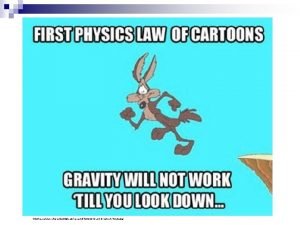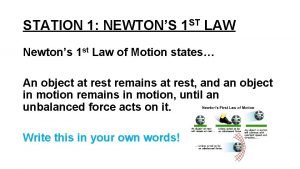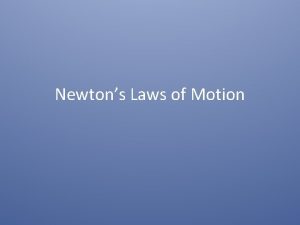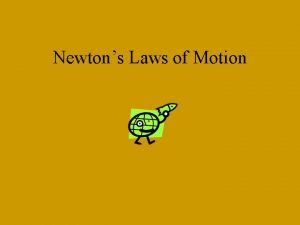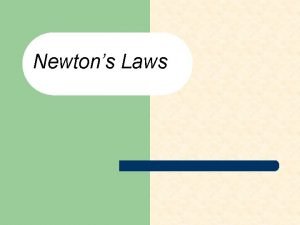Newtons Laws of Motion Newtons First Law the








- Slides: 8

Newton’s Laws of Motion

Newton’s First Law - the law of inertia • Inertia - an object’s resistance to a change in motion • It takes a force to change the speed or direction of an object. • Inertia is directly related to mass.

Examples of inertia: • Which is easier to push: a loaded shopping cart or an empty one? • You’re riding in a car and the driver slams on the brakes. What happens? • Your bratty nephew runs past you for the 14 th time. You stick out your foot and trip him. What happens?

Newton’s Second Law F =m x a • The mass of an object and the force applied to it affect its acceleration. • As the force on an object increases, the acceleration increases. • As the mass of an object increases, the acceleration decreases.

Newton’s Third Law action / reaction forces • For every force there is an equal and opposite reaction force. • When a runner pushes against the ground, the ground pushes back against the runner.

Newton’s Third Law action / reaction forces • Action-reaction forces are not the same as balanced forces. Action-reaction forces act on different objects. Balanced forces: Both people are pulling on the door. Action-Reaction forces: The diver pushes down on the board. The board pushes up on the diver.

Identify the Newton’s law that fits each situation. 1. An athlete can throw (accelerate) a baseball faster than. a shot put. 2. A person sitting in a boat tosses a heavy anchor in one. direction. The boat moves in the opposite direction. 3. A car skids on an icy curve and slides off the road. 4. F = m x a represents which of Newton’s Laws? 5. Which one of Newton’s Laws allows you to keep. jumping on a trampoline?

6. A boat moves through the water because of a rowing. motion (using oars). 7. When a car suddenly stops at a red light, a book lying on. the car seat slides forward. 8. A dropped basketball hits the floor and bounces back up. 9. It takes more force to accelerate a loaded dump truck. than it takes to accelerate a small car with one. passenger. 10. A cup of water sits motionless on a kitchen table.
